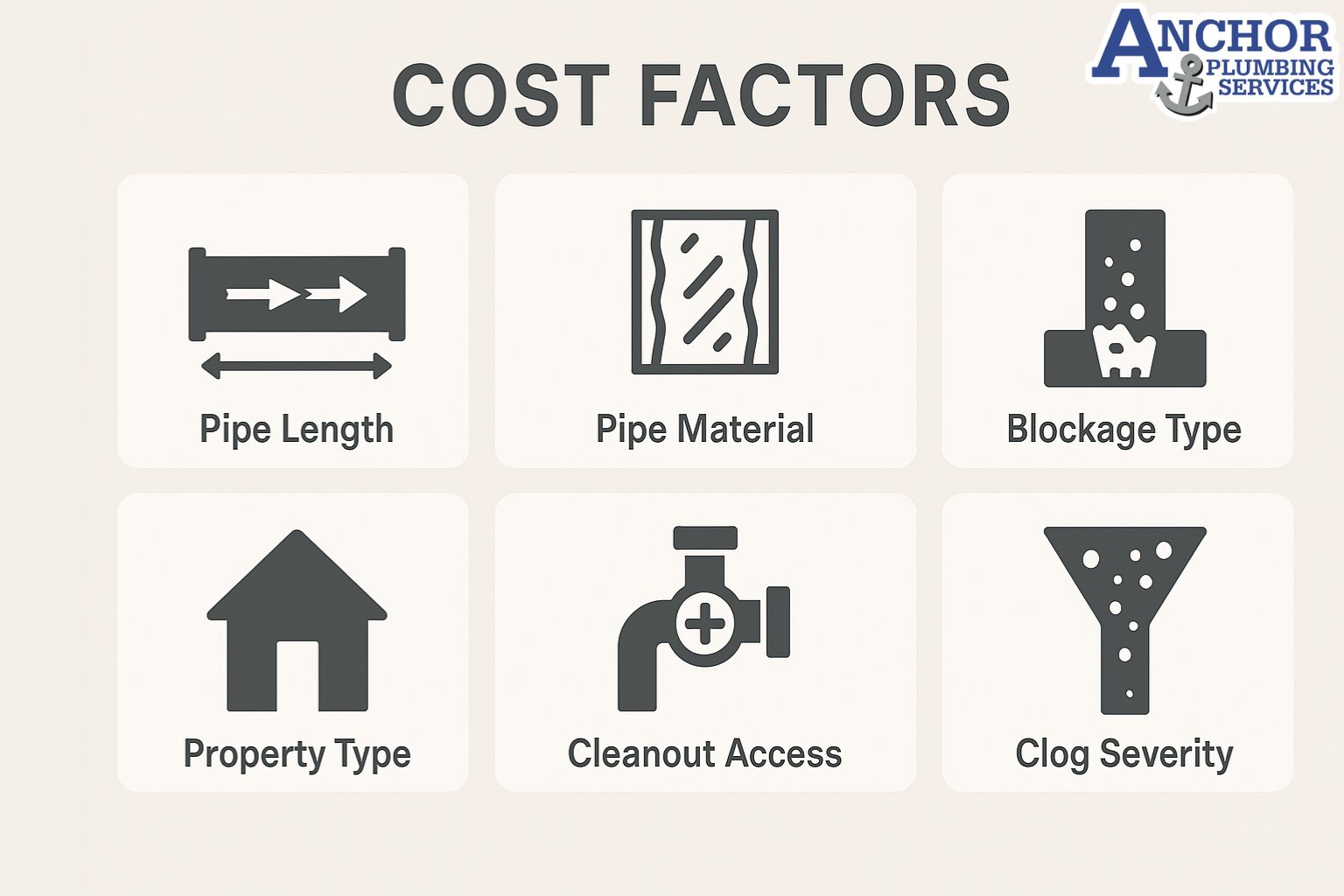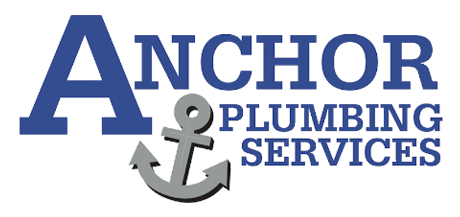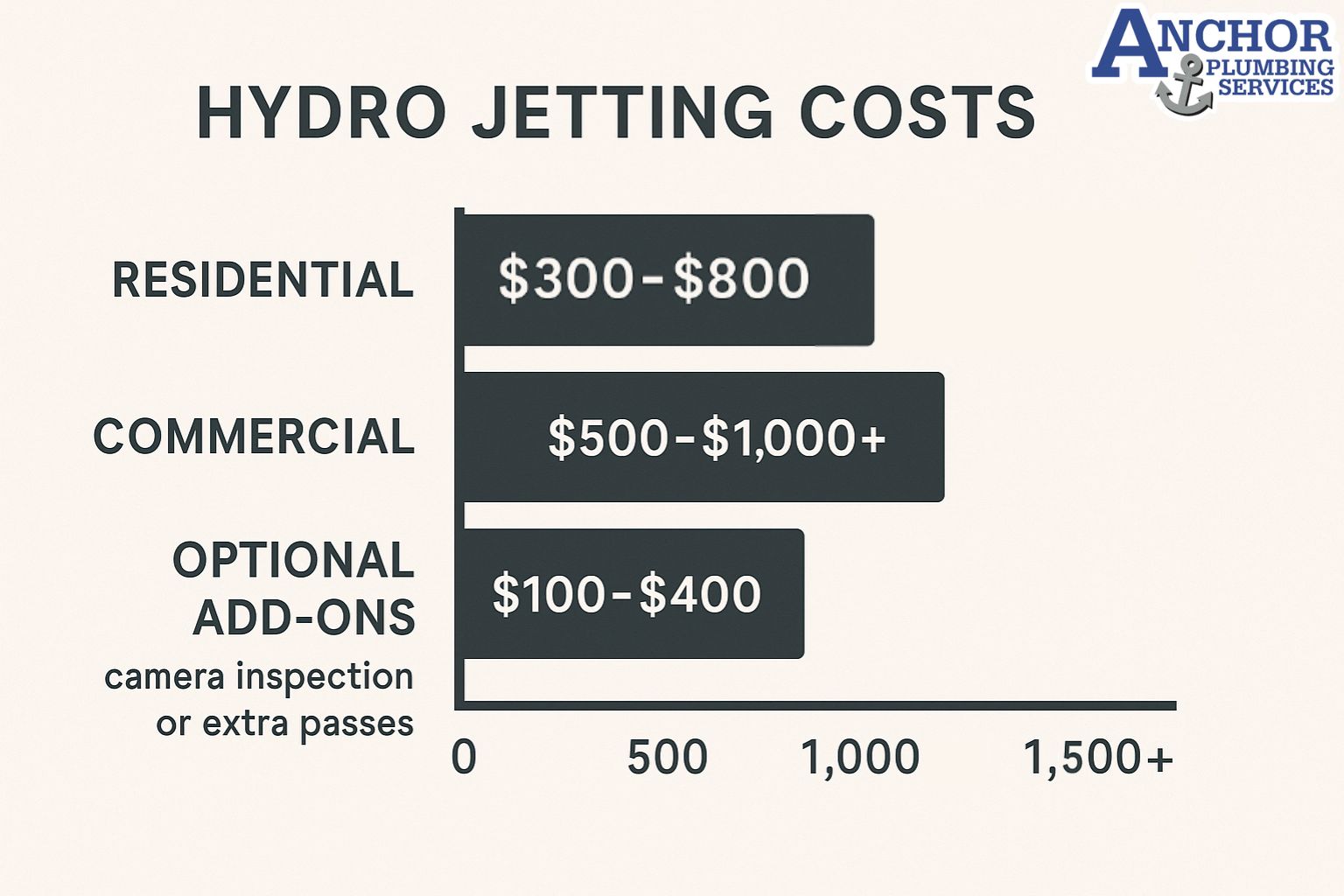Hydro jetting typically costs $300 to $800 for residential plumbing and around $1,000 for many commercial jobs. That price covers inspection, equipment setup, high-pressure cleaning, and a post-cleaning flow check. Your final quote depends on pipe length, clog severity, and how easily the technician can access a cleanout.
Hydro jetting is a powerful drain cleaning method that uses high-pressure water streams to remove grease, scale, tree roots, and debris from inside your pipes. The service usually includes a preliminary inspection, setup of hydro jetting equipment, and post-cleaning water flow tests to ensure full clearance.
Most homeowners pay on the lower end of the spectrum when the blockage is localized and easy to access. Costs rise when technicians work through multiple cleanouts or remove thick grease buildup. Flushing long sewer laterals to the city main also increases time. The price can increase if a video camera inspection or a return visit is needed.
How Much Does Hydro Jetting Cost?
Hydro jetting typically costs between $300 and $800 for most homes and around $1,000 or more for commercial systems. Pricing usually includes inspection, equipment setup, high pressure cleaning, and a final flow test to confirm that the line is clear.
Most residential hydro jetting quotes assume one main sewer line or a single branch line up to a set length, such as fifty to one hundred feet of pipe. The exact cost depends on line length, pipe diameter, and material type such as PVC, cast iron, or clay. Heavier blockages from grease, scale, or tree roots require higher pressure settings, different jetting nozzles, and more passes through the pipe, which increases labor time and total service price.
Cost Overview for Hydro Jetting
| Scenario | Typical Cost Range | What is Included |
|---|---|---|
| Single residential drain or branch | $300–$500 | Setup, jetting one line, basic flow test |
| Main residential sewer line | $400–$800 | Jetting main line, multiple passes, flow test |
| Small commercial line or grease line | $500–$900 | Jetting targeted line, basic grease removal |
| Large commercial or multi line system | $800–$1,500 | Multiple lines, heavy buildup, additional labor |
What Factors Affect the Cost of Hydro Jetting?

Price changes based on site conditions and system design. Expect higher quotes when the pipe is long, the blockage is heavy, or access is poor.
1. Pipe Length and Diameter
Longer pipe runs and wider diameters require more time and water pressure to clean effectively. Jetting a 10-foot kitchen line costs less than flushing a 100-foot sewer main.
2. Pipe Material and Condition
Older pipes made of cast iron or clay may require gentler pressure settings and careful handling. Fragile materials may increase the service duration and risk, affecting overall labor costs.
3. Severity and Type of Blockage
Grease buildup, mineral scaling, or tree root intrusion takes longer to clear than basic food waste or soap residue. Clogs that block full pipe flow are more labor-intensive and raise technician service time.
4. Property Type: Residential vs Commercial
Residential hydro jetting is typically faster due to simpler layouts and smaller plumbing systems. Commercial jobs often require larger jetting units and more labor, especially when working on restaurants or multi-unit drain systems.
5. Accessibility to Cleanouts
If the technician has easy access to a ground-level cleanout, the service proceeds efficiently. However, when cleanouts are buried, damaged, or located in crawlspaces, extra labor time and digging may be required.
During the site check, the technician selects the pressure range, nozzle type (e.g., penetrator or rotary), and equipment best suited to your line. Understanding these pricing drivers helps property owners make informed decisions before authorizing the service.
How Much Does Residential Hydro Jetting Cost?
For residential properties, hydro jetting costs usually range from $300 to $800 depending on the location and complexity of the clog. Most homes require a single technician and a basic hydro jetting rig for common drain lines like kitchen sinks, tubs, or main sewer pipes.
The final price depends on the square footage of the home, clog location, and how accessible the cleanout is. Homes with exterior access points for drain cleaning typically require less time and labor, making them more affordable to service.
Typical inclusions in residential hydro jetting include:
- Setup of high-pressure water equipment
- Flushing of one to two main drain lines
- Post-cleaning flow test
- Optional camera inspection (often billed separately)
Severe blockages, such as tree roots or heavy grease buildup, may increase cost due to the need for specialized nozzles or multiple cleaning passes.
Jetting is often recommended for homes experiencing slow drainage, recurring toilet backups, or after years without professional pipe cleaning.
What’s the Cost of Hydro Jetting for Commercial Properties?
Commercial hydro jetting usually costs more. Commercial systems are more complex and often require grease trap maintenance. These jobs also take longer, which raises labor time. Prices typically range between $500 and $1,000, depending on the facility size and plumbing layout.
Businesses often require larger equipment and multiple technicians to clear grease interceptors, long lateral lines, or multi-unit sewer connections. Restaurants, hotels, and commercial kitchens experience faster buildup of food waste, fats, and soap scum, making more frequent or intensive cleanings necessary.
Key pricing variables in commercial hydro jetting include:
- Number of drain lines or branches involved
- Volume and type of debris
- Pipe access during business hours or off-hours
- Whether grease traps are being cleaned simultaneously
For retail and hospitality properties, preventive jetting is often scheduled quarterly to reduce downtime and maintain health compliance.
Property managers can negotiate flat-rate service contracts to save on recurring cleanings and avoid reactive costs due to emergency blockages.
Are There Additional Costs Homeowners Should Expect?
Some providers charge $100–$400 extra for diagnostic inspections, sewer camera inspection, or additional jetting passes. These costs are not included in base hydro jetting quotes and can raise the total service amount by $100 to $400 depending on the job complexity.
A common add-on is a video camera inspection, which helps plumbers visually confirm the location and condition of the clog. Camera inspections are billed separately and typically cost between $150 and $300.
In some jurisdictions, permit fees may be required for extensive sewer line work, especially if the line connects to the municipal system or crosses property boundaries. These costs vary depending on city regulations.
Follow-up repairs, such as fixing broken pipes revealed during jetting, are not included in the initial price. When hydro jetting exposes cracked joints or corroded segments, the plumber provides a separate repair quote.
Other upsells include pipe relining, grease trap cleaning, or scheduled maintenance plans. While optional, these services can help prevent future blockages and reduce the need for frequent jetting.
By understanding what’s included and what counts as an extra charge, homeowners can better evaluate quotes and avoid unexpected fees.
How Can You Save Money on Hydro Jetting Services?
You can reduce hydro jetting costs by scheduling regular maintenance, bundling services, and avoiding emergency after-hours calls. Proactive planning often eliminates the need for urgent cleanings caused by neglected buildup or recurring clogs.
One of the most effective ways to control cost is to bundle hydro jetting with other plumbing services, such as camera inspections or annual pipe evaluations. Plumbing companies often offer package pricing for preventative maintenance.
Routine maintenance prevents debris buildup. It keeps high traffic drain lines clear and reduces the risk of emergency clogs. When performed regularly, hydro jetting sessions are shorter and less labor-intensive, lowering the technician’s service time and overall labor charge.
Homeowners can save by scheduling hydro jetting services during normal business hours and avoiding overtime or weekend rates. In commercial settings, coordinating jetting during planned maintenance windows can reduce downtime and help property managers avoid surprise backups.
Is Hydro Jetting Worth the Cost Compared to Snaking?
Yes, Hydro jetting costs more upfront than basic snaking, but it cleans the full pipe diameter instead of only punching through the clog. One hydro jetting visit can replace several snaking visits over time, which cuts long term maintenance spending.
Snaking is useful for minor blockages near a fixture. Hydro jetting is the better value when drains clog often, when there is heavy grease or scale, or when a property relies on sewer lines to stay open, such as restaurants or multi unit buildings.
What Are the Alternatives to Hydro Jetting and How Do They Compare?
Hydro jetting is more effective than snaking when dealing with grease buildup, scale deposits, or recurring clogs. However, there are alternative methods to consider based on clog severity and budget.
1. Mechanical Snaking
Snaking uses a flexible cable to break apart and retrieve clogs. It’s best suited for localized, soft blockages, such as hair or paper products. While cheaper than hydro jetting (typically $100–$300), it may not remove all residue from pipe walls, which can cause frequent re-clogging.
2. Chemical Drain Cleaners
These store-bought solutions offer short-term relief but can damage older pipe materials. They are generally ineffective for deep or hardened clogs and should be avoided for routine use.
3. Enzymatic Drain Treatments
Enzyme-based cleaners break down organic waste over time and are safe for monthly maintenance. They do not clear active blockages but help prevent buildup in kitchen lines and bathroom drains. Enzymatic products are best used as a supplement to jetting, not a replacement.
For a minor clog, snaking or an enzymatic treatment may be enough. But for complete pipe restoration and long-term prevention, hydro jetting remains the most thorough and effective method.
Frequently Asked Questions About Hydro Jetting
How much does hydro jetting cost?
Hydro jetting costs typically range from $300 to $800, depending on pipe length, clog severity, and service location. Commercial jobs exceed $1,000 due to larger systems and higher labor requirements.
Is hydro jetting worth the price?
Yes, hydro jetting is worth the price for homes and businesses with recurring clogs or stubborn blockages. It offers long-term value by restoring full pipe flow and reducing future plumbing issues.
What affects the cost of hydro jetting?
Factors like pipe material, blockage type, accessibility to cleanouts, and whether camera inspections or permits are needed can significantly affect the total cost.
How often should I get hydro jetting done?
Most homeowners benefit from hydro jetting every 18 to 24 months, especially if they have older plumbing systems or experience frequent slow drains or backups.
Is hydro jetting safe for old pipes?
Hydro jetting is generally safe, but older or brittle pipes should be inspected first. A plumber may recommend a lower pressure or alternate method if there’s risk of damage.
Can I DIY hydro jetting or should I hire a professional?
DIY hydro jetting is not recommended. Professional equipment generates the high water pressure required to clean pipes safely and effectively without causing damage.
How does hydro jetting compare to snaking?
Hydro jetting removes full pipe buildup, while snaking only breaks through the blockage point. Jetting is more thorough and ideal for greasy or large-scale obstructions.
Is hydro jetting covered by insurance?
Most home insurance policies do not cover hydro jetting unless damage is caused by a sudden or covered event. Always check your policy or ask your provider for clarification.
What’s included in a hydro jetting service?
A standard hydro jetting service includes equipment setup, line flushing, and a post-cleaning inspection. Camera diagnostics or additional repairs may be billed separately.
Conclusion
Hydro jetting is a powerful investment in your plumbing health, offering both immediate relief from tough clogs and long-term protection against future backups. While the upfront cost varies between $300 and $800, the value of a clean, fully restored plumbing system often outweighs the expense—especially when compared to recurring snaking visits or water damage repairs.
Understanding your pricing options helps prevent surprise repairs and allows you to choose the right service for your property. For residential systems, hydro jetting keeps drains flowing and prevents buildup in kitchen and bathroom lines. For commercial properties, it ensures business continuity by keeping sewer lines, grease traps, and high-traffic drains clear.
Whether you schedule jetting as a preventative measure or need it to resolve an urgent clog, choosing a qualified professional ensures your plumbing receives the right treatment at the right pressure. Hydro jetting is not just a cost—it’s a strategy to extend the life of your entire plumbing system.


